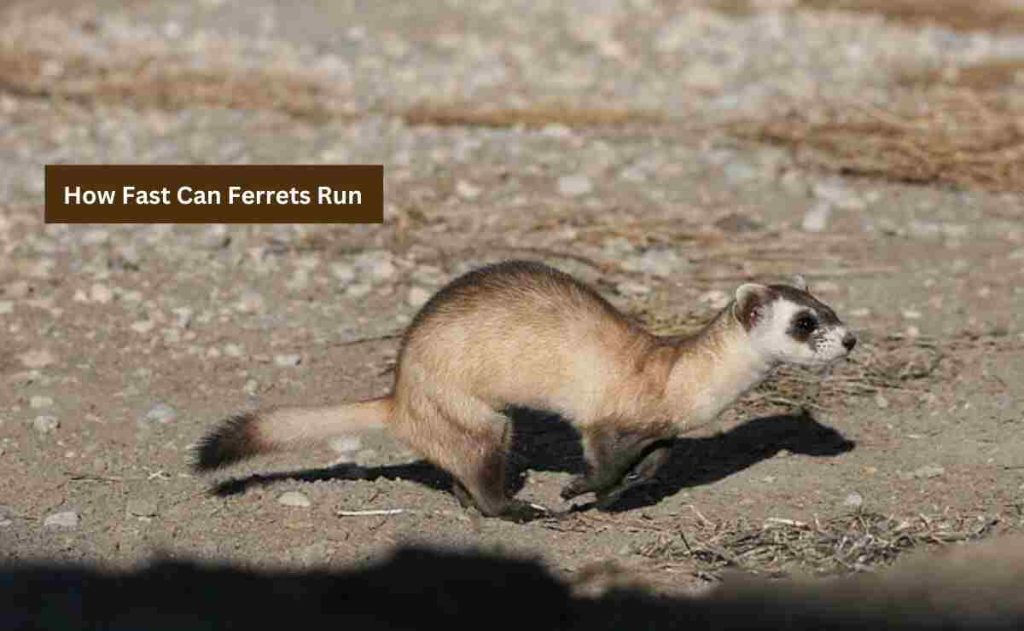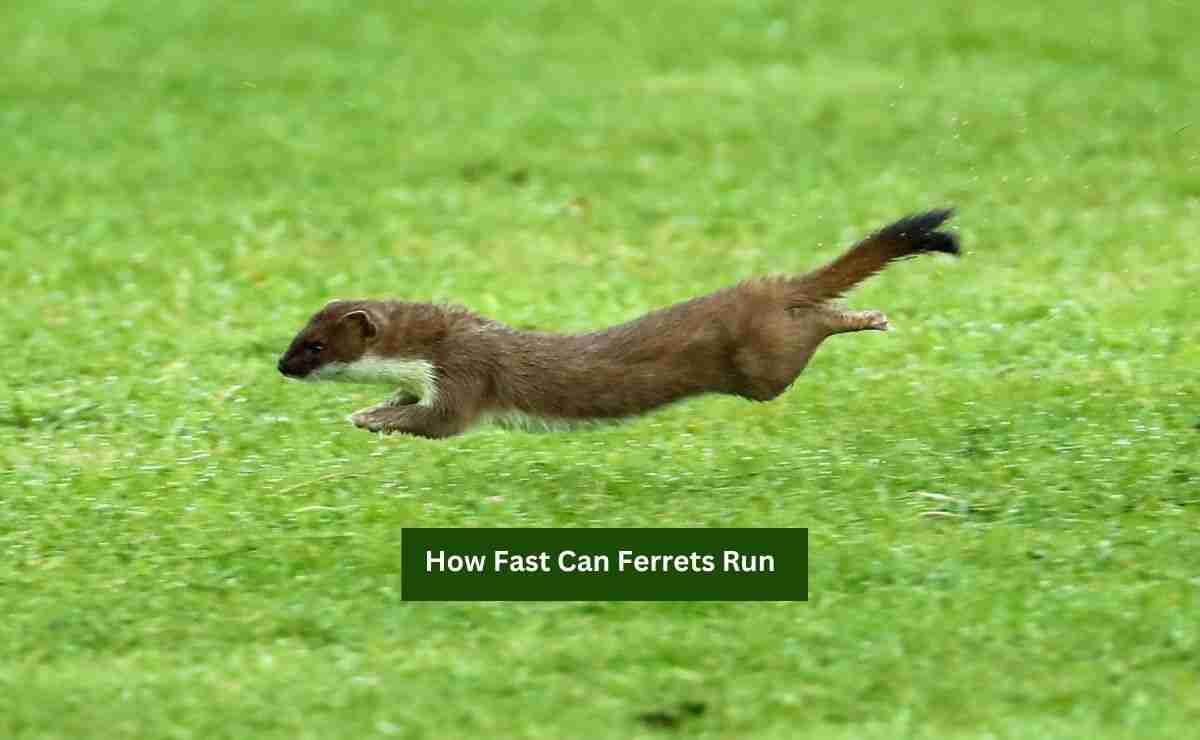Ferrets are small, agile mammals known for their quick and swift movements. They can move at a relatively fast pace. Ferrets look like small creatures, yet their lightning-quick movements leave us surprised.
So, how fast can ferrets run? On average, ferrets can run at a speed of around 30 miles / 48 kilometers or more per hour. However, truly, the speed of a ferret can vary depending on various factors, such as age, health, and size.
How Fast Can Ferrets Run?

Ferrets have a playful nature and they are pretty fast as small animals. In the wild, they prey animals and built for running and chasing. Even in domestic conditions, their movement is very fast while playing around.
The way ferrets move, dart around and chase each other, shows how much energy they have. Ferret’s body structure makes them fast creatures. They have long bodies, short legs, and long curved claws that give low center gravity and grip as they run. So they can quickly make sharp turns and instant stops that help catch prey and hide.
As we said earlier, their average running speed is 30 miles per hour. But it’s not the fastest speed they can reach. They can run faster when threatened and sometimes, the speed reaches up to 40 miles per hour, known as “flight speed”. The moment, they try to escape from predators, their running speed bursts.
So the actual speed depends on the situation. However, the age and health condition also impact on their running ability. Younger and healthier ferrets are able to run slightly faster than their older or less active counterparts. Additionally, the size of a ferret can also impact their speed, as larger ferrets may not be as agile or quick as smaller ones.
When it comes to measuring the speed of a ferret, it is best to do so in a controlled environment, such as a safe and enclosed space. This will ensure the safety of the ferret and allow for accurate observation of their running speed.
Ferrets Physical Structure For Running
It is well known that ferrets have a lively disposition and are true speedsters with impressive agility. Their ability to execute sudden bursts of speed stems from a combination of factors. A flexible spine and a long, streamlined body empower ferrets to navigate through tight spaces effortlessly.
At the core of a ferret’s physical prowess lies a muscular structure that is finely tuned for speed and agility. Strong, powerful legs enable these creatures to run and leap with impressive ease. The well-developed muscles not only contribute to their swift movements but also play a crucial role in their hunting and play activities.
Beyond strength, ferrets possess special adaptations that make them adept navigators in their environment. Sharp claws serve as versatile tools, aiding in climbing and digging, essential for exploration and hunting.
The long, flexible bodies of ferrets provide a unique advantage, allowing them to effortlessly slip through narrow openings. As if this weren’t enough, their keen sense of smell acts as a guiding compass, helping them locate prey and maneuver their surroundings with precision.
What Factors Affect A Ferret’s Running Speed?
When it comes to a ferret’s running speed, several factors come into play. These factors can contribute to the speed at which a ferret can move and may vary from one ferret to another.
- Genetics
Genetics plays a crucial role in determining a ferret’s running speed. Just like in any other species, individual ferrets are born with inherent physical traits that can affect their athletic abilities.
Some ferrets may be naturally faster than others due to their genetic makeup and innate physical capabilities. It is important to note that while genetics can certainly influence speed potential, environmental factors, and training can still impact a ferret’s actual running speed.
- Health
Another significant factor impacting a ferret’s running speed is its overall physical health. Ferrets that are in good shape and have a healthy body composition will generally be able to run faster than those with underlying health issues or obesity.
A healthy diet, regular exercise, and proper veterinary care can all contribute to enhancing a ferret’s physical well-being and, consequently, their running abilities.
- Running Surface
The type of surface or terrain the ferret runs on also plays a role. Ferrets naturally excel at quickly maneuvering through tight spaces and navigating obstacles.
However, their agility and speed might be affected by the quality and condition of the surface they run on. Smooth and even surfaces typically allow for faster running speeds, while rough or uneven terrains can hinder their performance.
- Age
Age and maturity levels can impact a ferret’s running speed. Like humans and many other animals, ferrets may experience changes in their physical capabilities as they age.
Younger ferrets have more energy and are able to reach higher speeds, while older ferrets might show a decrease in their overall running abilities. Ferret owners need to consider these age-related factors and adjust their expectations accordingly.
- Training
Lastly, training and socialization can significantly contribute to a ferret’s running speed. Ferrets that have been exposed to various environments, stimuli, and positive reinforcement training are generally more confident and better prepared to run at their full potential.
If you provide opportunities for play, exercise, and mental stimulation, it can establish a solid foundation for a ferret’s overall physical fitness and speed.
How Does The Speed Of A Ferret Compare To That Of A Dog?
Both dogs and ferrets are known for their agility and quickness, but there are some key differences in their physical capabilities.
Ferrets are small, nimble creatures that are known for their ability to move quickly and change direction with ease. They are built for speed, with long, slender bodies and strong muscles.
While exact speed measurements for ferrets can vary, they are generally capable of reaching speeds of up to 30 miles per hour in short bursts. This makes them highly adept at navigating their environment and catching prey.
On the other hand, dogs come in a wide variety of breeds, each with their own unique traits and characteristics. Some dog breeds, such as greyhounds and whippets, are known for their exceptional speed and can reach impressive speeds of up to 45 miles per hour over short distances. These breeds are built for chasing prey and are often used in racing competitions.
However, it’s important to note that not all dog breeds are as fast as greyhounds or whippets. The average speed of a dog is about 15 to 20 miles per hour. It can vary greatly depending on factors such as breed, size, and individual training.
While some dogs may not be as quick as ferrets, they make up for it with their endurance and ability to sustain a steady pace for longer distances.
Conclusion
Ferrets are truly amazing creatures, boasting a set of impressive physical abilities, with speed and agility taking center stage. Although they may not claim the title of the fastest runners, ferrets possess a distinctive blend of traits perfectly appropriate for hunting and play.
Ferrets can run faster compared to many small animals in their category. Watching a ferret’s swift movements can be enjoyable for any ferret owner, whether they are playfully zipping around the house or taking them outside for a run.
